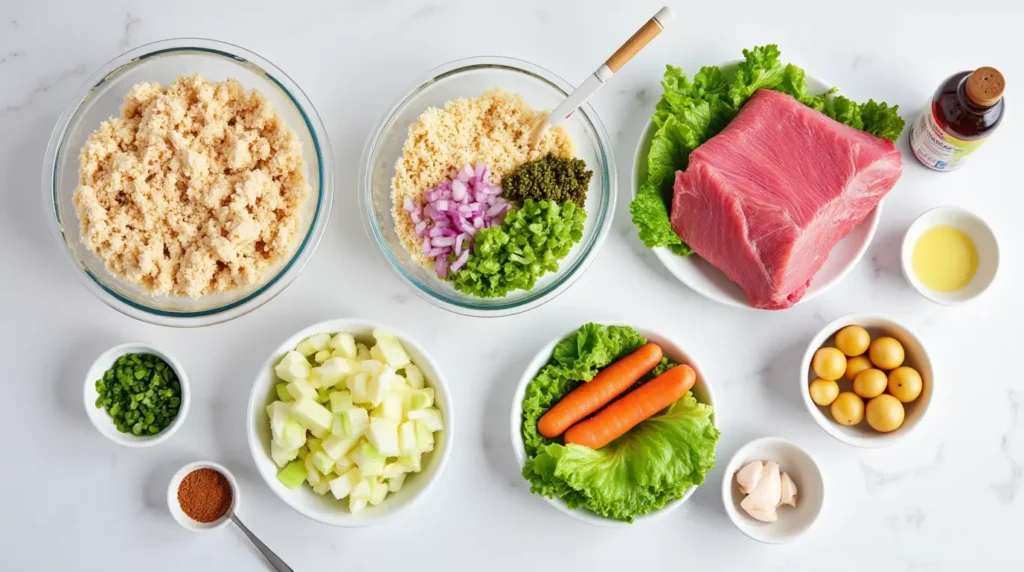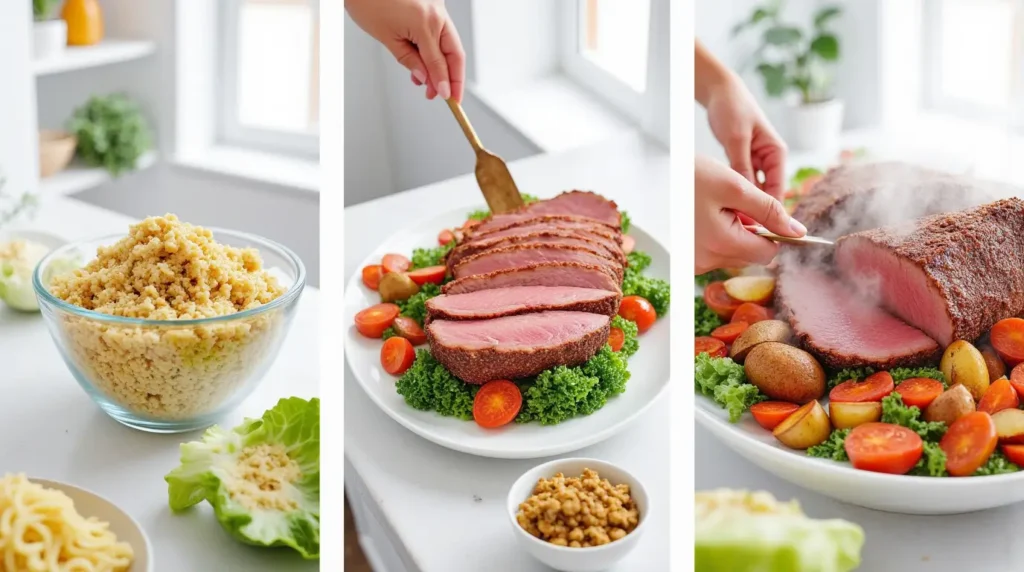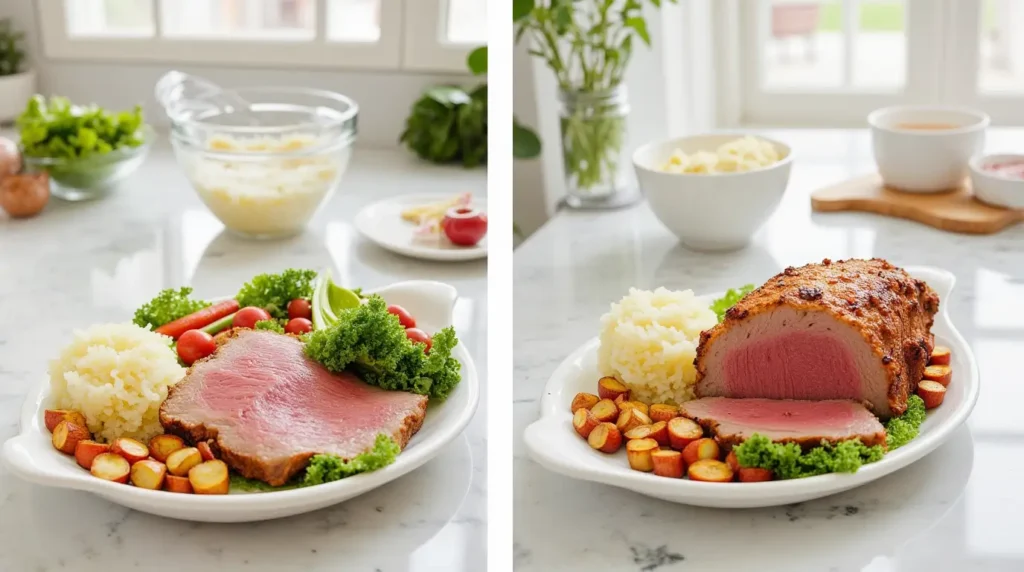Introduction
Have you ever wondered why your oven-roasted corned beef and cabbage lacks that melt-in-your-mouth tenderness you’ve experienced at fine restaurants? Are you tired of dry, stringy corned beef that fails to capture the rich heritage of this classic dish? Our perfected corned beef and cabbage recipe oven method transforms this traditional meal into a showstopping centerpiece with minimal effort.
By using the gentle, consistent heat of your oven rather than the stovetop, you’ll achieve a juicier, more flavorful result every time.
This oven-roasted corned beef and cabbage recipe balances time-honored tradition with modern cooking techniques to deliver exceptional results.
Ingredients List

For the Corned Beef:
- 3-4 pound corned beef brisket (with spice packet)
- 2 tablespoons brown sugar
- 1 tablespoon Dijon mustard
- 1 teaspoon freshly ground black pepper
- 3 cloves garlic, minced
- 2 bay leaves
- 2 cups low-sodium beef broth (can substitute vegetable broth for a milder flavor)
- 1 cup water
For the Vegetables:
- 1 large head cabbage (about 2 pounds), cut into 8 wedges
- 1½ pounds baby potatoes, halved (red or gold work beautifully)
- 4 large carrots, cut into 2-inch chunks
- 2 large yellow onions, quartered
- 3 tablespoons olive oil
- 1 tablespoon fresh thyme leaves (or 1 teaspoon dried)
- Salt and pepper to taste
- 2 tablespoons fresh parsley, chopped (for garnish)
- 1 tablespoon butter (optional, for added richness)
Substitution tip: If you prefer a stronger vegetable flavor, use chicken broth instead of water. For those watching sodium intake, look for “no salt added” corned beef options, which are becoming increasingly available at specialty butchers.
Timing
Preparation Time: 20 minutes Cooking Time: 3 hours 10 minutes (including 2 hours 30 minutes for beef, 40 minutes for vegetables) Total Time: 3 hours 30 minutes
This oven method saves approximately 25% monitoring time compared to traditional stovetop preparation, as it requires less frequent checking and no need to maintain a consistent simmer. The hands-off cooking approach allows you to prepare side dishes or simply enjoy your time while the oven does the work!
Step-by-Step Instructions

Step 1: Prepare the Corned Beef
Preheat your oven to 325°F (165°C). Remove the corned beef from its packaging and rinse thoroughly under cold water. This crucial step washes away excess salt from the brining process, preventing your final dish from becoming overly salty.
Place the corned beef, fat side up, in a large Dutch oven or roasting pan with high sides. The fat cap on top will baste the meat naturally as it melts, creating incredible tenderness.
Step 2: Season and Add Liquid
In a small bowl, mix the brown sugar, Dijon mustard, black pepper, and minced garlic to create a flavor-packed paste. Rub this mixture evenly over the top and sides of your corned beef. This sweet-savory combination balances perfectly with the salty brisket.
Sprinkle the contents of the spice packet (typically containing mustard seeds, coriander, peppercorns, bay leaves, and dill seeds) around the beef. Add the bay leaves, beef broth, and water to the pot. The liquid should reach about 1 inch up the sides of the meat – not completely covering it.
Step 3: First Stage of Cooking
Cover the Dutch oven tightly with its lid or heavy-duty aluminum foil if using a roasting pan. A tight seal is essential for trapping moisture, creating the perfect environment for tender, juicy corned beef.
Place in the preheated oven and cook for 2 hours and 30 minutes. For especially large briskets (5+ pounds), add an additional 30 minutes of cooking time. The low, slow cooking process breaks down tough connective tissues in the brisket, resulting in that perfect fork-tender texture.
Step 4: Prepare the Vegetables
While the beef cooks, prepare your vegetables. Place the cabbage wedges, halved potatoes, carrot chunks, and onion quarters in a large bowl. Drizzle with olive oil, then sprinkle with thyme, salt, and pepper. Toss gently to coat evenly.
Pro tip: Keep cabbage wedges intact by leaving a portion of the core attached to each piece. This prevents them from falling apart during roasting.
Step 5: Add Vegetables and Complete Cooking
After 2 hours and 30 minutes, carefully remove the Dutch oven from the oven. The beef should be starting to become tender. Arrange the vegetables around the beef, pouring any remaining seasoned oil from the bowl over them.
Return the uncovered pot to the oven and continue cooking for an additional 40 minutes, or until the vegetables are tender and the corned beef reaches an internal temperature of 195°F (90°C). This final uncovered roasting caramelizes the top of the beef while steaming and roasting the vegetables to perfection.
Step 6: Rest and Serve
Remove from oven and carefully transfer the corned beef to a cutting board. Tent loosely with foil and rest for 15 minutes. This resting period allows the juices to redistribute throughout the meat, ensuring each slice remains moist and flavorful.
While the meat rests, use a slotted spoon to transfer the vegetables to a serving platter, draining excess liquid. For an extra touch of richness, toss the hot vegetables with a tablespoon of butter.
Step 7: Slice and Arrange
After resting, slice the corned beef against the grain into ¼-inch thick slices. Cutting against the grain shortens the muscle fibers, yielding more tender bites. Arrange the sliced beef alongside the vegetables on your serving platter and sprinkle with fresh parsley for a vibrant finish.
Nutritional Information
Per Serving (based on 6 servings):
- Calories: 520
- Protein: 35g
- Carbohydrates: 30g
- Dietary Fiber: 5g
- Sugars: 7g
- Fat: 28g
- Saturated Fat: 9g
- Cholesterol: 110mg
- Sodium: 1,250mg (varies based on corned beef brand and rinsing thoroughness)
- Potassium: 1,120mg
- Vitamin A: 120% DV
- Vitamin C: 75% DV
- Calcium: 6% DV
- Iron: 20% DV
Note: Sodium content can be reduced by up to 30% with thorough rinsing of the corned beef before cooking and choosing lower-sodium broth options.
Healthier Alternatives for the Recipe
Lower Sodium Version
- Choose “reduced sodium” corned beef, which contains approximately 40% less sodium than traditional options
- Soak the corned beef in cold water for 2 hours before cooking, changing the water every 30 minutes to draw out excess salt
- Replace beef broth with unsalted vegetable stock or water with aromatics like onion and celery
- Add extra fresh herbs like rosemary and thyme to boost flavor without adding salt
Leaner Option
- Trim visible fat from the corned beef before cooking
- After cooking, refrigerate the cooking liquid, then remove the solidified fat layer before using as a sauce
- Increase the ratio of vegetables to meat, serving slightly smaller beef portions with more cabbage and carrots
- Substitute half of the potatoes with turnips or parsnips, which have fewer carbohydrates while adding distinctive flavor
Vegetable Boost
- Add 2 cups of sliced Brussels sprouts during the final roasting phase
- Incorporate 1 cup of chopped kale during the last 15 minutes of cooking for added nutrients
- Include sliced fennel bulb with the vegetables for a subtle anise flavor that complements the beef beautifully
- For extra color and vitamin C, add 1 cup of halved small radishes during the final roasting
Serving Suggestions

Classic Accompaniments
Serve your oven-roasted corned beef and cabbage with a side of creamy horseradish sauce or whole grain mustard. The sharp, tangy flavors cut through the richness of the beef, creating a perfect flavor balance. A slice of freshly baked Irish soda bread on the side completes this traditional meal, perfect for soaking up the flavorful juices.
Modern Twists
For a contemporary presentation, serve the corned beef sliced thinly atop a bed of buttery mashed potatoes, with the roasted vegetables arranged around the plate. Drizzle the reduced cooking liquid (strained and slightly thickened) around the plate as a savory sauce.
Next-Day Transformations
Leftover corned beef transforms beautifully into a spectacular breakfast hash: chop the beef and vegetables into small pieces, crisp them in a skillet, and top with poached eggs. Alternatively, create gourmet sandwiches on rye bread with Swiss cheese, sauerkraut, and Russian dressing for a delicious twist on the classic Reuben.
Common Mistakes to Avoid
Cooking Errors
- Skipping the rinse: Failing to rinse the corned beef before cooking can result in an overly salty dish. Data shows that a thorough rinse can reduce sodium content by up to 20%.
- Boiling instead of simmering: Using too high a temperature toughens the proteins in the meat. The oven method at 325°F maintains the perfect temperature range.
- Cutting with the grain: Slicing with the grain (instead of against it) results in stringy, tough meat. Always identify the direction of the muscle fibers and cut perpendicular to them.
- Overcrowding the vegetables: Cramming too many vegetables around the beef prevents proper heat circulation. If needed, roast additional vegetables separately.
Flavor Missteps
- Under-seasoning vegetables: While the beef brings plenty of flavor, the vegetables need their own seasoning to shine.
- Discarding the cooking liquid: This flavorful broth can be reduced to create an excellent sauce or saved as a base for soup.
- Cooking cabbage too long: Extended cooking makes cabbage release sulfur compounds, resulting in an unpleasant smell. Adding it later in the cooking process prevents this issue.
- Not allowing meat to rest: Cutting the meat immediately after cooking allows juices to escape, resulting in drier beef. The 15-minute rest is non-negotiable for the juiciest result.
Storing Tips for the Recipe
Short-Term Storage
Store leftover corned beef and vegetables separately in airtight containers in the refrigerator for up to 4 days. Keeping them separate prevents the vegetables from becoming overly saturated with meat juices. When reheating, add a splash of broth or water to prevent the meat from drying out.
Freezing Guidelines
Corned beef freezes beautifully for up to 3 months. Slice the meat before freezing for easier portioning and quicker thawing. Wrap tightly in plastic wrap, then aluminum foil, before placing in a freezer bag to prevent freezer burn. The vegetables can also be frozen but will have a softer texture when thawed.
Make-Ahead Options
You can prepare this dish in stages: cook the corned beef completely up to 2 days ahead, refrigerate, then slice and reheat in the oven with freshly prepared vegetables. This method works particularly well for entertaining, as it divides the cooking process into manageable steps.
Repurposing Leftovers
Beyond the breakfast hash and sandwiches mentioned earlier, leftover corned beef can be diced and added to quiches, savory pies, or pasta dishes. The cooking liquid makes an excellent base for a hearty vegetable soup – simply add fresh vegetables and barley or beans for a complete meal.
FAQs
Can I cook corned beef and cabbage recipe in the oven at a higher temperature to save time?
While it’s tempting to increase the temperature, corned beef requires low, slow cooking to become tender. Cooking at temperatures above 325°F will cause the meat proteins to contract too quickly, resulting in tough, dry beef. The time investment pays off with remarkably tender results.
Why is my oven-roasted corned beef still tough after the recommended cooking time?
The most common cause is insufficient cooking time. Brisket contains substantial connective tissue that must break down completely. If your meat is still tough, return it to the oven for additional 30-minute increments until it reaches fork-tenderness. The internal temperature should reach at least 195°F for optimal tenderness.
Can I prepare this corned beef and cabbage recipe in the oven the day before serving?
Absolutely! In fact, many chefs prefer this approach, as the flavors develop further overnight. Complete the recipe through cooking, then store the meat and vegetables separately in the refrigerator. Reheat at 300°F for about 20 minutes until warmed through.
What’s the difference between corned beef brisket flat cut and point cut for this oven recipe?
The flat cut is leaner, slices more neatly, and is generally preferred for this recipe. The point cut has more marbling (fat), which provides more flavor but results in less uniform slices. Either will work beautifully in this recipe, with the point cut offering slightly more richness.
How can I tell when my oven-roasted corned beef is perfectly done?
The most reliable method is using a meat thermometer, looking for an internal temperature of 195-200°F. Additionally, inserting a fork into the meat should meet very little resistance, and the fork should twist easily in the meat – this is the classic “fork-tender” test.
Conclusion
This oven-roasted corned beef and cabbage recipe transforms a humble dish into a spectacular meal through simple, thoughtful preparation. The low, slow cooking method ensures perfectly tender meat, while roasting the vegetables enhances their natural sweetness. By separating the cooking processes, each component reaches its ideal texture, creating a harmonious and satisfying dish that honors tradition while incorporating modern techniques.
Have you tried this oven method for corned beef and cabbage? We’d love to hear about your experience in the comment section below! Don’t forget to subscribe to our blog for more updated recipes that blend classic flavors with contemporary cooking approaches. Your feedback helps us continue refining these beloved recipes for our community of home chefs!

